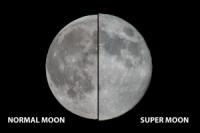
Not so big a difference –supermoon vs normal full moon
The media has been full of stories about tonight’s “supermoon,” which is the largest in 68 years. Supermoon is the popular term for what astronomers call a moon perigee–syzygy. This means that the moon is at its closest point to earth in its elliptical orbit and that the earth, moon, and sun are in alignment, resulting in a full moon. The last time the moon was this close to the earth was in 1948, and the next comparable supermoon will be in 2032.
Also associated with the supermoon is the so-called “king tide.” Tides normally vary with the phase of the moon, being higher or lower on days where the moon is full or there is a new moon. The king tide associated with a supermoon, called a perigean spring tide, is generally a few inches higher than a normal spring tide.
Is the supermoon a big deal? Opinions vary widely. Continue reading

 The
The 

 The destroyer
The destroyer  The mystery of the
The mystery of the  Today, 29 sailors set off from Les Sables-d’Olonne, France in the eighth
Today, 29 sailors set off from Les Sables-d’Olonne, France in the eighth 
 Alain Thébault
Alain Thébault The
The  The Littoral Combat Ship (LCS) USS Montgomery suffered another hull crack, this time while transiting the Panama Canal on Sunday. “Under control of the local Panama Canal Pilot, the ship impacted the center lock wall and sustained an 18-inch-long crack between her port quarter and transom plates,” according to
The Littoral Combat Ship (LCS) USS Montgomery suffered another hull crack, this time while transiting the Panama Canal on Sunday. “Under control of the local Panama Canal Pilot, the ship impacted the center lock wall and sustained an 18-inch-long crack between her port quarter and transom plates,” according to  Giant pumpkin paddling is apparently a new, hot water sport, with competitions around the globe. Who knew? From Nova Scotia, to Maine, Wisconsin, Minnesota, Oregon, Germany and the United Kingdom, people are carving out giant pumpkins, hopping aboard with a paddle and competing in regattas and solo events.
Giant pumpkin paddling is apparently a new, hot water sport, with competitions around the globe. Who knew? From Nova Scotia, to Maine, Wisconsin, Minnesota, Oregon, Germany and the United Kingdom, people are carving out giant pumpkins, hopping aboard with a paddle and competing in regattas and solo events. Last month,
Last month,  We are about six months behind on this update, but it is a worthwhile topic to catch up on. In January of 2015, we posted
We are about six months behind on this update, but it is a worthwhile topic to catch up on. In January of 2015, we posted  In the end of August,
In the end of August,  Fifty two years ago today, the world came perilously close to being destroyed in a nuclear World War III. Fortunately, one brave Soviet naval officer stood in the way.
Fifty two years ago today, the world came perilously close to being destroyed in a nuclear World War III. Fortunately, one brave Soviet naval officer stood in the way. While much of the focus has been on the melting of the Arctic ice cap,
While much of the focus has been on the melting of the Arctic ice cap,